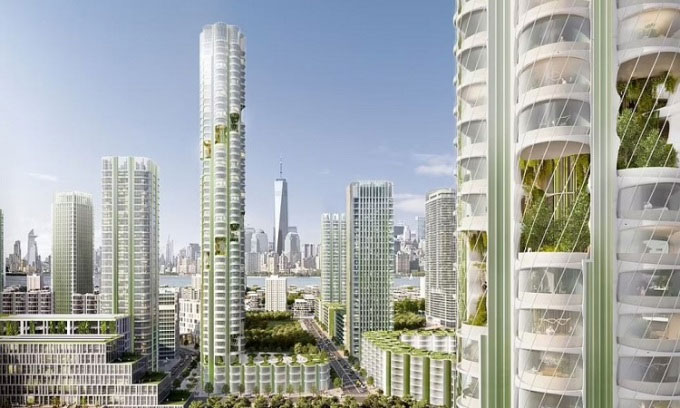Designers have introduced a skyscraper model named “Urban Sequoias,” capable of removing a carbon footprint equivalent to that of 48,500 trees from the atmosphere.
Named after the tallest tree species in the world, this innovative design comes from the architectural firm Skidmore, Owings & Merrill in Chicago, utilizing current available technologies. Each skyscraper will incorporate various techniques to capture carbon, including construction with carbon-absorbing materials, planting greenery and algae (for fuel, energy, and food), along with direct air capture technology. The “stacking effect” from the design helps draw air into the building’s center for carbon filtration.

Design of the carbon-capturing skyscraper Urban Sequoias. (Photo: Skidmore, Owings & Merrill)
The design firm states that with a lifespan of at least 60 years, Urban Sequoia can absorb four times the amount of carbon released into the atmosphere compared to the carbon generated during its construction. The captured carbon can be used to produce bio-materials for roads, sidewalks, pipelines, and more, contributing to urban infrastructure development.
While the prototype is a skyscraper that captures 1,000 tons of carbon annually, the carbon capture methods employed can be applied to buildings of all shapes and sizes. Building materials such as bio-bricks, bio-concrete, hempcrete, and timber can reduce the carbon output from construction by 50% compared to traditional concrete and steel.
According to Skidmore, Owings & Merrill in Chicago, the carbon captured per square kilometer could reach 120 tons if urban landscapes are transformed into gardens, reconstructing cities as carbon-absorbing structures and equipping streets with additional carbon capture technology. This figure could nearly triple if applied in parks and other green spaces.
Urban Sequoia is a highly ambitious project and unlikely to become a reality in the near future. Experts estimate that construction worldwide accounts for nearly 40% of global carbon emissions. They urge the construction industry to address this issue. As a result, buildings made from wood materials are becoming increasingly popular, providing a sustainable alternative to concrete. The Urban Sequoia design was presented by Skidmore, Owings & Merrill at the United Nations COP26 Climate Change Summit on November 11.


















































